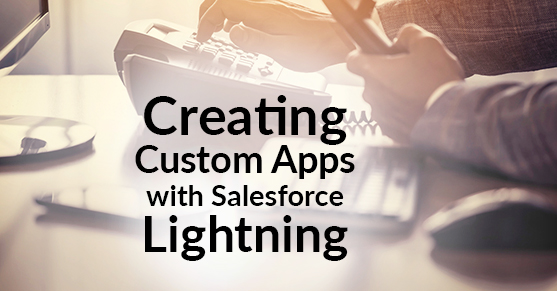A distinct function of the Salesforce Lightning Experience is that it offers inside sales and sales management teams the ability to create custom apps. If you’re new to the Lightning Experience, you may not know what Lightning apps are or how to use them, so let’s flush them out a bit.
What are Custom Lightning Apps?
Lightning apps allow users to create a collection of collaborative items to access specific objects, tabs, or other critical Salesforce items they need. Lightning apps present a unique experience to the Salesforce user, giving them an overarching bundle of necessary tools to navigate Salesforce and efficiently complete projects.
In design, every Lightning app can include a customized utility bar or page tabs so that whatever your teams need, they can switch to it without leaving their specific app. Sales reps can navigate through accounts and opportunities, while sales managers can hop back and forth between reports and various dashboards. For each team, users can put several things in their app: standard objects (Chatter, Groups, People, Home, etc.), custom objects, and various tabs, including Visualforce, Lightning component, and Web tabs. The navigation bar allows users to easily search and find items, access records/lists, and complete action items all in one place.
By picking your tabs and objects, Custom Lightning Apps allows admins to hide Tabs and Objects from users who have no use for them, essentially acting as a decluttering tool for organizations. This is especially critical for implementation. Keeping your salesforce solution simple by hiding unnecessary tabs with Custom Apps can lead to greater confidence with Salesforce and improved adoption.
If you’re looking to access a whole new level of efficiency with Salesforce Lightning, look no further than custom Lightning Apps.
How to Build a Custom Lightning App
The best part of Lightning apps is that they’re incredibly easy to make. Within minutes, users can create their app name, set the visuals (like color and brand logo), identify the items/tabs to appear in the dashboard, and assign it to the appropriate user profiles.
Before we jump into the app-building process, we recommend meeting with your teams and going through everything the app will include before launching them. Try to organize internal user group meetings with each team to hash out how they want their unique Lightning app to look. Run through their priorities, figure out which objects/items mean the most to them and allow them to do their job. Get a list going, review it with each team, and then get started on the final product. (Even if you decide to exclude some items from certain apps, if a member of that group needs it, they can easily access it through the App Launcher.)
After you’ve done the prerequisite “soul-searching” for your Lightning app, you can start putting it together. In three easy steps, you’ll have your custom app ready to rock.
- Step One: Begin by clicking the Home Tab in Setup, enter “app” in the Quick Find box. Once the results come up, select the “App Manager” and click “New Lightning App.”
- Step Two: The New Lightning App Wizard will instruct you on providing pertinent details for creating your app, as shown in the table below.
| Name | Whatever name your team would like to use. |
| Description | A brief description of the app. |
| Image/Logo | You can have a little fun with the image/logo you choose for your Lightning app. You can use a JPG, PNG, and BMP (so long as it’s 128×128 pixels or smaller), and you can even have a GIF (max 5 MB) as your app logo. |
| Brand Color | Whatever color value fits your brand. (For us here at XTIVIA, it’d be either Green: #00965E or Cyan: #0C71C3. |
| Options | Select the appropriate options for your team’s needs |
| Utility & Navigation Items | You can choose from a variety of Utility and Navigation options like accounts or Chatter to best suit the app. |
| User Profile | Assign the app to whichever team will be using it. |
- Step Three: Click “Save and Finish” and exit the Lightning App Wizard. Now, your new app is visible in the App Launcher drop-down menu.
And you’re done! You now have a custom Lightning app your team can use to take their workday to the next level.
Creating custom Salesforce Lightning apps is another great way to personalize your Salesforce system and promote better engagement and efficiency from your teams. With each Lightning app, you replace tedious item/object navigation with streamlined access at your fingertips.
If you have any questions or concerns, engage with us via the comment section below. Or, you can always get in contact with our team of Salesforce experts here.
For additional reading on how to get the most out of the Lightning Experience, check out some of our tips on migration, load speed improvements, implementation strategies, and more.
This post was originally published here.

